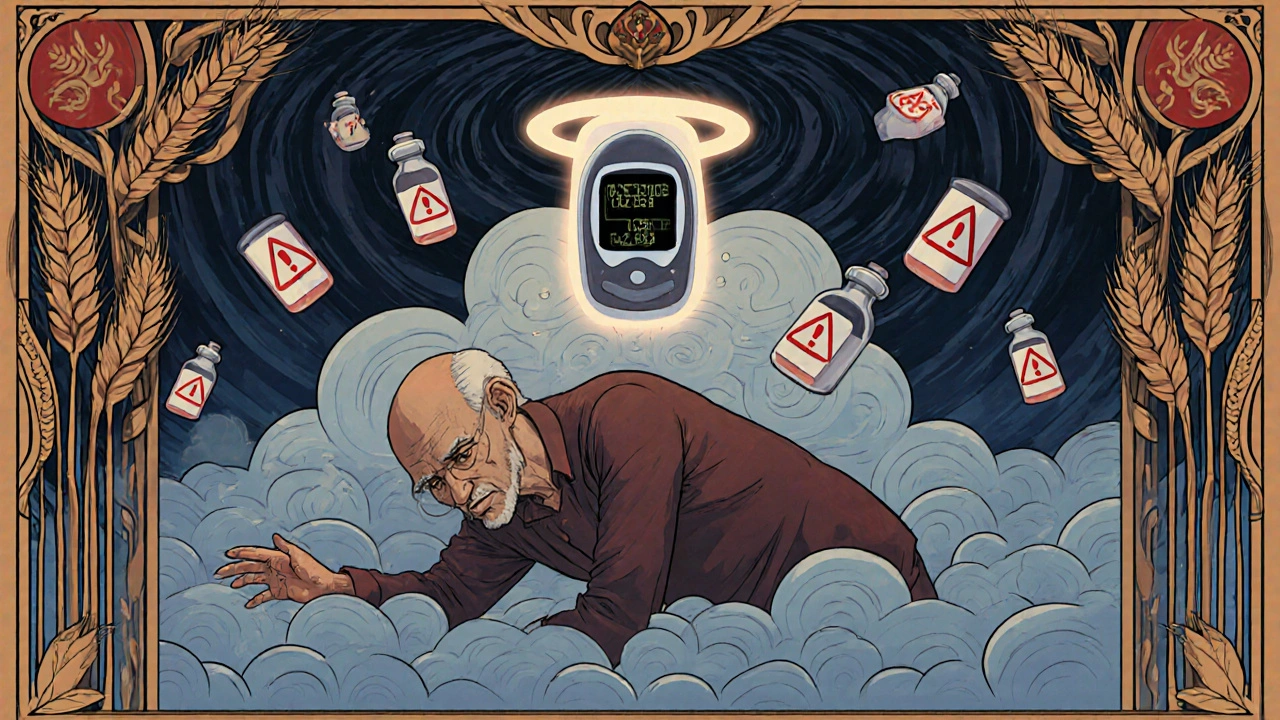Diabetes Medication Side Effects and How They Affect Glucose Control

Nov, 10 2025
Diabetes Medication Side Effect Risk Calculator
How Your Health Profile Affects Medication Choices
This tool helps you understand how your specific health conditions and lifestyle impact medication side effects and glucose control. Based on information from the article about diabetes medications, we'll identify the best options for your situation.
Your Health Profile
When you're managing diabetes, taking your medication isn't just about lowering blood sugar-it’s about keeping your whole body stable. But many people don’t realize how often those pills or injections come with unexpected consequences. Side effects from diabetes drugs can throw your glucose levels into chaos, make daily life harder, or even lead to serious health risks. And if you’re one of the half of patients who stop taking your meds within the first year, you’re not alone. The real problem isn’t the disease-it’s how the treatment makes you feel.
Metformin: The First-Line Drug With Hidden Costs
Metformin is the most common diabetes medication, prescribed to about 80% of Type 2 patients. It’s cheap, effective, and doesn’t cause low blood sugar. But for 20 to 30% of people, it brings stomach problems: nausea, bloating, diarrhea, and a constant feeling of being queasy. These side effects aren’t minor-they’re why so many people quit taking it.
The good news? There are ways to make it tolerable. Starting with a low dose-500 mg once a day with food-and slowly increasing over weeks helps your body adjust. Extended-release versions like Glucophage XR or Fortamet cut GI issues by about 25% compared to regular metformin. Still, even with these tweaks, some people never get used to it.
There’s another hidden risk: vitamin B12 deficiency. After four or more years on metformin, 5 to 10% of users develop low B12 levels. That means fatigue, dizziness, numbness in hands and feet, and even memory problems. It’s not something most doctors routinely check for. If you’ve been on metformin for years and feel constantly tired, ask for a B12 test. Taking 1,500 mcg daily can reverse it.
Sulfonylureas: The Hypoglycemia Trap
Drugs like Glipizide and Glimepiride force your pancreas to pump out more insulin. That lowers blood sugar fast-but it can drop too low. About 15 to 20% of users experience hypoglycemia, often without warning. Symptoms? Sweating, shaking, confusion, fast heartbeat. In severe cases, people pass out or have seizures.
What makes this worse is that these side effects hit hardest in older adults, people with irregular meals, or those who exercise without adjusting their dose. The 15-15 rule helps: eat 15 grams of fast-acting sugar (like juice or glucose tabs), wait 15 minutes, check your blood sugar. If it’s still low, repeat. But prevention is better than reaction. Continuous glucose monitors (CGMs) reduce severe low blood sugar episodes by 40%, making them essential for anyone on sulfonylureas.
And there’s another catch: weight gain. These drugs add 2 to 4 kilograms over time. For someone already struggling with insulin resistance, that extra weight makes diabetes harder to control. That’s why many endocrinologists now avoid them unless other options aren’t working.
SGLT2 Inhibitors: Weight Loss With Hidden Dangers
Drugs like Jardiance, Farxiga, and Invokana work by making your kidneys flush out extra sugar through urine. The result? Lower blood sugar, weight loss (2-3 kg in six months), and better heart and kidney protection. But the trade-off is serious.
Women face a 4 to 6% risk of genital yeast infections. Men get them too, but less often-1 to 2%. Urinary tract infections (UTIs) happen in 5 to 10% of users. One Reddit user, u/DiabeticDad, wrote: “Jardiance dropped my A1c from 8.2 to 6.8, but I got three UTIs in six months. I switched.”
Worse, there’s a rare but deadly risk: diabetic ketoacidosis (DKA), even when blood sugar isn’t high. This happened in 0.1 to 0.2% of users. Symptoms: nausea, vomiting, abdominal pain, confusion. If you feel this way while on an SGLT2 inhibitor, test for ketones immediately. Don’t wait.
There’s also a small but real risk of foot and leg amputations-especially with canagliflozin. The FDA added a black box warning after the CANVAS trial showed a 0.3 to 0.5% higher risk. And then there’s Fournier’s gangrene, a rare, fast-spreading genital infection. The FDA tracked 55 cases between 2013 and 2018. Good hygiene and staying hydrated are your best defenses.

TZDs: The Heart Failure Risk
Actos and Avandia make your body respond better to insulin. But they also make you retain fluid. That leads to swelling in the legs, sudden weight gain, and shortness of breath. For someone with heart failure, that’s dangerous. Rosiglitazone (Avandia) was linked to a 33% higher risk of heart attack in a 2007 study. The FDA restricted it. Pioglitazone (Actos) is safer, but still carries a 43% higher risk of hospitalization for heart failure compared to other drugs.
Because of this, guidelines now say: don’t use TZDs if you have Class III or IV heart failure. If you’re over 65, have swelling in your ankles, or feel winded climbing stairs, talk to your doctor before starting these.
Alpha-Glucosidase Inhibitors: Gas, Bloating, and Social Isolation
Drugs like Precose and Glyset slow down how fast your body digests carbs. That helps prevent blood sugar spikes after meals. But the undigested carbs don’t disappear-they go to your colon, where bacteria feast on them. The result? Massive gas, bloating, and diarrhea. Up to 30% of users can’t handle it.
It’s not just uncomfortable-it’s embarrassing. People avoid social meals, skip gatherings, or stop taking the drug entirely. These medications are rarely used today, except in rare cases where other drugs aren’t suitable. Even then, many patients switch after a few weeks.

Choosing the Right Drug: It’s Not One-Size-Fits-All
There’s no perfect diabetes drug. Each has trade-offs. Metformin is safest for most people-low hypoglycemia risk, possible heart benefits, and cheap. But if your stomach can’t take it, you’re stuck. SGLT2 inhibitors help your heart and kidneys and help you lose weight-but they bring infections and rare but deadly risks. Sulfonylureas work fast but cause lows and weight gain. TZDs? Avoid unless you’re young, healthy, and have no heart issues.
The key is matching the drug to your life. If you’re active and fit, an SGLT2 inhibitor might be ideal. If you’re older with kidney problems, metformin wins. If you’ve had a heart attack, SGLT2 inhibitors or GLP-1 agonists are preferred. If you’re worried about cost, metformin is still the answer-most SGLT2 drugs cost $500 to $600 a month without insurance.
What No One Tells You: Side Effects Are Manageable
A Mayo Clinic survey found 68% of patients felt their doctor didn’t warn them about side effects. That’s a failure of communication. You shouldn’t have to guess why you feel awful.
Here’s what you should ask your doctor:
- What side effects are most likely with this drug?
- How do I know if it’s the medicine or something else?
- What should I do if I get these symptoms?
- Are there cheaper or better-tolerated alternatives?
And if you’re struggling, don’t quit. Talk. Adjust. Switch. Many side effects fade over time. Others can be prevented with simple steps: take metformin with food, drink water with SGLT2 inhibitors, carry glucose tabs if you’re on sulfonylureas. Your doctor isn’t just treating your A1c-they’re treating your life.
What’s Next: Better Drugs on the Horizon
Science is catching up. New combination pills like Xigduo XR (metformin + dapagliflozin) reduce stomach issues by 25%. New TZDs like INT131 are in trials with 60% less fluid retention. And genetic testing is coming: if you carry the ADL-1 variant, you’re 3.2 times more likely to get bad GI side effects from metformin. That means future prescriptions could be personalized before you even start.
Long-term, glucose-responsive insulin and closed-loop systems may replace pills entirely. But for now, managing side effects is part of the job. The goal isn’t just to lower blood sugar-it’s to help you live without fear, discomfort, or danger.
Can diabetes medication side effects be avoided entirely?
No, side effects can’t be avoided entirely because they’re built into how these drugs work. But they can be minimized. Starting with low doses, choosing extended-release forms, staying hydrated, and monitoring for early symptoms reduces risk. Switching medications when side effects are severe is not a failure-it’s smart management.
Why do some people tolerate metformin better than others?
It’s partly genetics. People with the ADL-1 variant are over three times more likely to get severe stomach issues. It’s also about how you take it-taking metformin with food, using extended-release versions, and slowly increasing the dose helps. Some people just have more sensitive stomachs. That doesn’t mean the drug won’t work-it just means you need to adjust how you use it.
Is it safe to stop diabetes medication if side effects are too bad?
Never stop without talking to your doctor. Stopping suddenly can cause your blood sugar to spike dangerously. Instead, ask for alternatives. If metformin gives you constant diarrhea, try the extended-release version. If SGLT2 inhibitors cause frequent UTIs, switch to a GLP-1 agonist. There are many options. The goal is to find one that works for your body-not to suffer through the wrong one.
Do SGLT2 inhibitors really protect the heart and kidneys?
Yes. Large studies show they reduce the risk of heart failure hospitalization by 30% and slow kidney disease progression in people with Type 2 diabetes. That’s why guidelines now recommend them for patients with heart or kidney disease-even if their A1c is already under control. The benefits outweigh the risks for these groups.
How do I know if my low blood sugar is from my medication or something else?
If you’re on sulfonylureas or insulin, low blood sugar is likely medication-related. But it can also come from skipping meals, drinking alcohol, or over-exercising. Keep a log: note when lows happen, what you ate, your activity level, and your dose. If lows happen after meals or during sleep, that’s a red flag for medication overuse. A continuous glucose monitor gives you the clearest picture.
